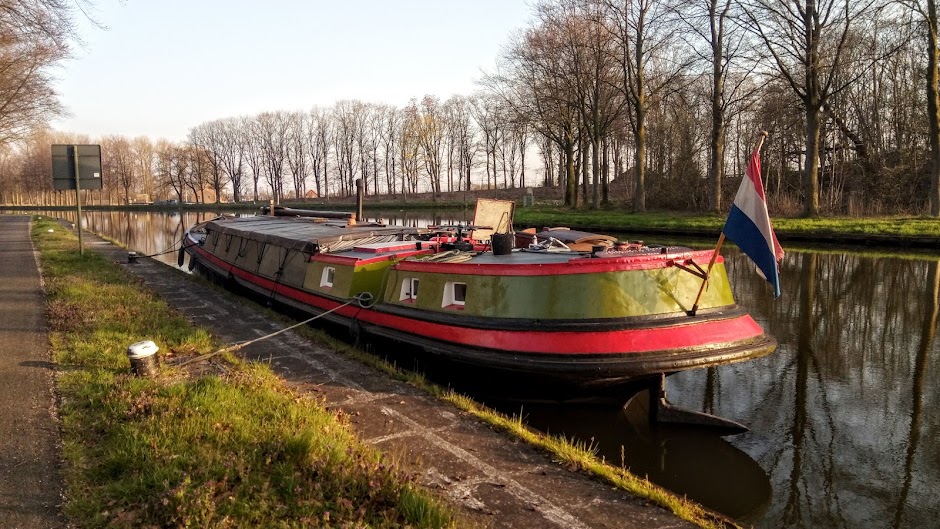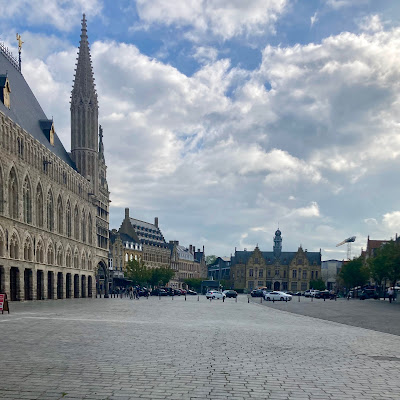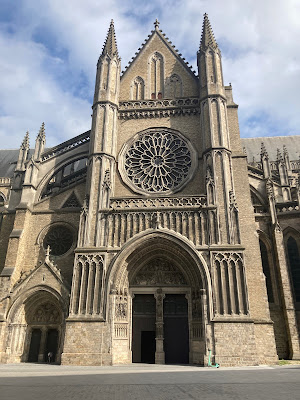My apologies for the delay again. I can barely believe it's over a month ago now that we were on the boat in Belgium. In my last post, we'd reached Roesbrugge on the upper IJzer, a small town, but one of some significance as it lies close to the border with France and has a long history dating back to the 13th century. What brings the town to the news more often, however, is the flooding that occurs now and then and for which the upper IJzer as a whole is known.
 |
| The beautiful IJzer |
For us, it will remain imprinted in our memories for two reasons: the first being the heat – it was the day the temperatures soared to 35C – and the second was the smell.
Having taken shelter next to the pontoon under the bridge, we sat out the sweltering afternoon to the accompaniment of a somewhat unpleasant pong. At first we thought we'd caused it by stirring up the mud in our efforts to turn around a little way upstream (see previous post) but that wasn't the case.
 |
| Looking upstream to France from whence said pong came |
We hadn't been settled for very long when a young man from the environment authority came to assess the situation.
"There's been a lot of rain," he said, "and the sewers over the border in France have overflowed into the river. That's why it smells so bad."
Koos and I looked at each other and grimaced. We decided very quickly we weren't going to use the river water for anything, not even cleaning the decks, and I definitely didn't want Zoe drinking it. Even so, during the afternoon, some teenage girls came with paddle boards and dressed in only the skimpiest bikinis, started floating around in the water. Koos, of course, didn't mind seeing this kind of eye candy, but I shuddered to think what they were dangling their legs in.
Anyway a short time later, we also had a visit from the fire brigade in an inflatable boat. They were coming to take samples of the water. Cheerful and friendly, they confirmed the problem with the overflowing sewers in France and mentioned it happened in Roesbrugge too in times of heavy rainfall. In any event, it seemed the solution was to oxygenate the water and an hour or so later, they installed a pump and hosepipe on the bank about a hundred metres from our mooring to aerate the water. It was still busy the following day when we headed back the way we'd come although I can't say the smell had diminished all that much.
 |
| Some interesting 'art' alongside the river at Roesbrugge |
We spent a pleasant evening nonetheless and enjoyed walking along the footpath next to the river. Another pair of youngsters came to the pontoon to inflate their canoe and set off for an evening on the water. They told us they were heading for Diksmuide but when I looked surprised that they'd be going so far, they sheepishly admitted they probably wouldn't get anywhere close before turning back. Diksmuide is a good 25 km from Roesbrugge by water. When they were fully pumped – so to speak – we wished them good speed and waved them off, hoping they'd get as far as they wanted before the beers they'd taken slowed them down. After they'd gone, the evening cooled to a balmy softness and we ate on deck while the interior of the Hennie H was cooling down. Despite the heat of the day, the night air was delicious and we slept exceptionally well that night.
When we set off in the morning, we did so just after a large group of school children in kayaks who'd arrived en masse and started loading their craft into the (still sniffy) water. While we were preparing to leave, we saw them disappearing around the bend so we lingered a little fearing to catch up with them too quickly and disrupt their canoeing. We needn't have worried. We'd travelled several kilometres before we reached them, but they were thankfully all well trained and tucked themselves into the bank to let us pass. It struck me then what a great activity it was for the kids. Being out on the river in kayaks, enjoying nature, the (even sniffy) water and the scenery seemed so healthy.
With cooler weather and no stops, we were back at Fintele within two hours. The French couple who'd helped us so kindly the day before were still on the moorings and we waved to them in passing. Beyond the turning into the lock, the river became suddenly more disciplined and continued so all the way to the turning to Ieper. The rural wilderness gave way to more organised banks and farms that lacked the sense of adventure we'd found on the upper IJzer.
Roughly 7 km from Fintele, we turned right and south into the canal to Ieper (Ypres). By this time, we were both ready for a break but it was a good 5 km (more than half an hour) before we found somewhere to stop. In the event, it was an ideal pontoon with easy access to land where we found a large green space, a car park and a restaurant. Not much, you might think, to attract us, but then Koos has a hungry camera and he found a feast of subjects in that rather plain space to feed his lens.
 |
| Our perfect pontoon on the way to Ieper. We shared it with locals enjoying the hot evening. |
What struck me most was a sign that told us that Steenstraete, which was the name of the nearby hamlet, was where the first gas attack was made during WWI, a sobering reminder of how much the area had suffered. The sign also mentioned there'd formerly been a monument on the site but that the Germans had blown it up in 1941. What we didn't see was the monumental cross erected to replace it. That aside, it once again made me keenly aware we were in the middle of some of the most tragic history of the last century.
 |
| Koos will always find some subject for a photo |
It seems improbable but I can't help thinking Zoe was affected by the vibe there too. She refused to go for walks along the towpath and I was limited to taking her up to the patch of grass at the top of the steps. Maybe she sensed something lingering in the soil. Who knows? Anyway, that evening, we did manage to persuade her across the road to go for coffee and ice cream at the Steenstraete Eetcafé and very good it was too.
In the morning, we spent some time cleaning our Shoe to prepare her for our visit to Ieper, one of the most important points on our trip. We only had about ten kilometres to go but this included two locks which had to be arranged as they were operated individually.
On arrival, we called the lock-keeper who took a while to reply. Apparently, he was busy at the other lock and would be with us shortly. He turned out to be a very helpful and friendly gent who took our ropes to loop them over the bollards and even asked if we were ready before filling the lock. At the next lock, he repeated the process and told us just to call him when we were returning the next day.
"He gets my vote for lock keeper of the year," I said to Koos.
He grinned. "Well, there haven't exactly been many of them, have there? And what about the ones at Fintele?"
I laughed. "Hmm, yes, they were great too, weren't they? Okay, let's say they all deserve a mention."
The last stretch into Ieper was fairly unremarkable, which made our arrival and discovery of the town even more special. The harbour master beckoned us to a perfect spot alongside the pontoon. Okay, it was in full sun, but I'd covered all our windows with pieces of white tarpaulin I'd cut to size and they really helped against the heat. The price for the night was nearly as high as it was in Veurne, but we had electricity and water available, which counted for a lot.
Once we'd settled, I left Zoe in Koos's care and trudged off to the Aldi with my shopping trolley. At only a kilometre from the boat, I counted that a blessing and, even better, the walk along the old, unfinished canal from Ieper to Komen was a treat. Apparently begun in 1864, it was never completed because they needed to dig a tunnel through a ridge whose (probably sandy) composition meant it kept collapsing. They even attempted to raise the canal by means of locks, but they were unsuccessful for the same reason and attempts were abandoned in 1913 before WWI broke out. It seems such a shame because it would be a terrific short cut for boats from Ieper, Diksmuide and Nieuwpoort through to Wallonia and France. The current way around is roughly 150 km from Ieper. Had the canal been completed, it would have been a quick 15 km to reach the same point on the Leie river.
During the evening, we walked to the Menin Gate to witness the Last Post celebration. I find it humbling to know it is done every evening at 8 p.m. throughout the year and, I'm sure, never ceases to be deeply moving. The haunting sound of the bugle brought tears to my eyes. For me, having recently written my book about faring to the Somme, being there felt like another way of paying my respects to all those who lost their lives, their homes and their land during that terrible war.
We walked back to the boat through the city centre and I was amazed at how grand and how beautiful Ieper was. I honestly thought I'd been to Ieper before but realised I'd only ever walked around the marina and its environs. There was so much I hadn't seen, so I took myself and Zoe for a good walk around the centre in the morning before we left so I could absorb some of its ageing beauty and Flemish elegance. Much of the centre was badly damaged during the war but has been rebuilt faithfully and it would be hard to tell now what is original and what is post war. Here are some of the photos I took of the centre.
I think I'd better stop again here and finish our trip in my next post. Luckily, I have all the photos and my journal to remind me as the detailed memories are already fading along with the long summer evenings.
Autumn is coming to us here in Europe, so I wish all my fellow northerners a happy fall and to those in the south, enjoy the coming spring! Have a good week, allemaal.
















What a nice trip you have had! And Ypres (Ieper) is really wonderful!
ReplyDeleteKathleen, thank you. As you know, I love Belgium and Ieper is a jewel. We had a wonderful holiday, and there's more to come on my blogs. xx
DeleteSo glad you got to Ypres (Ieper) and attended the Last Call. Definitely worth it.
ReplyDeleteYes, thank you! Ieper and especially the Last Post were beautiful!
DeleteThank you Val, another lovely blog with some amazing photos, always so interesting my friend and this week especially so for me! Lally x
ReplyDeleteThank you so much, Lally. I know how much it means to you. xxx
DeleteDear Val, what an adventurous few days, despite the unpleasant river water which was best avoided. I love that you went to Ypres, where we went to see my husband's great-uncle's name on the Menin gate, and his brother's grave out in the country, found after considerable research. I just had to pop off and look and my photos of Ypres, and yes, I have the same cathedral and buildings in the city, all beautifully restored. When you see the photos of the original devastation it is incredible how well they restored it all. As it happens, my grandfather was also in Ypres during WW1, and fortunately survived. Thank you for a great post, which enlightened my day.
ReplyDeletePatricia, I agree. The devastation I saw in the photos of the time looked horrific. They've done a fabulous job with restoring the city. Your grandfather must have been appalled and damaged by the war, but I'm so pleased he survived. xx
DeleteAnother enjoyable post from your travels Val, thank you. The river looks lovely, apart from the smelly bit, I enjoyed the photo's along the way. Those sculptures were interesting, looked like giant Poppy seedheads and your photos of the cathedral really good. To think it was extensively rebuilt is quite impressive.
ReplyDeleteI shall look forward to your next, final instalment.
Autumn is officially with us, the Equinox was a few days ago. No real signs of it yet in the trees but I'm hoping for plenty to photograph soon.. We haven't had much colour in the last few years. Take care, David
David, my apologies for the late response. I wrote one yesterday but it seems to have got lost in cyberspace. I'm so pleased you enjoyed the photos. That means a lot to me from a photographer as accomplished as you. Ieper was a very moving experience altogether. The dedication to the Last Post ceremony as well as the faithful reconstruction of the town impressed me immensely. If you see the photos of the destruction, it's amazing they have revived the town so beautifully. Not all towns have recovered so well.
DeleteI meant to mention the evening ceremony at the Menin Gate. I first heard of it a few years ago and have seen it on TV, it always gives me a lump in my throat & a tear or two. The folk there are very respectful for the Allied Troops and what they did for them. David
DeleteYes, it's wonderful that they still honour those who died every single day. It gives real meaning to the 'lest we forget' phrase often heard on Remembrance day.
DeleteWhat a lovely trip Val along such beautiful waterways. Your photos are great and I particularly enjoyed seein the ones of Ypres again. It's quite a remarkable reconstruction when you compare it to the destruction of it during the war. We enjoyed visiting the In Flanders Field Museum housed in the wonderful Cloth Hall. Of course the Last Post at the Menin Gate was a moving experience for all of us, especially our students who laid the wreath. Glad to see Zoe out and about enjoying her walks. x
ReplyDeleteThank you, Rebecca. I know you’ve seen many of these photos on WLM, but I’m glad you enjoyed them again. What a worthwhile and moving trip for your students as well as you! It is good to put them in touch with real history in context. Zoe loved all the new places and smells :)
DeleteI'm the mystery Anonymous who didn't add my name!
ReplyDeleteHaha, thank you!
DeleteAs always, lovely and fascinating photos and blog. I can't imagine such high temperatures, since we only had 1 day of "summer" here and two more days of almost summer. It sounds wonderful! Your entire blog about your trip is wonderful. A subject for dreams tonight! (steph)
ReplyDeleteThanks you, my friend. Your comments always make me smile. ❤️
DeleteThank you, Val for sharing this portion of your trip through your very descriptive writing and photographs. I am happy that you two survivved the heat and the stench from the floods in France. I laughed about the girls or eye candy for Koos and understood Zoe's hesitancy to be around such a historically tragic site. Look forward to the next post!
ReplyDeleteAh, Lynn, many thanks for reading my post. It was a bit long, I know, but I’m glad you saw the humour in the girls paddling around our boat. Yes, I still wonder if it was the vibe of Steenstraete that made Zoe so reluctant to walk there.
DeleteAnother fascinating account, Val, thank you so much. I love the photos - gosh, Koos really does have a great eye with his photography. As for Zoe, I'm sure she sensed something. How very strange! xx
ReplyDeleteThank you so much, Beth. I’m so pleased you enjoyed it. Yes, Koos can be in the most mundane place and find images to feed his photographic soul. :)
DeleteIeper does look lovely! The history of the area is very sad. I believe my grandfather was there in the First World War but the medals were sold later because they needed the money post-war.
ReplyDeleteI wish I knew your name. I find it very sad that your grandfather had to sell his medals. He went through so much!
Delete